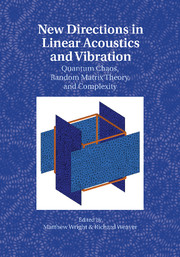Book contents
- Frontmatter
- Contents
- Foreword by Michael Berry
- Introduction
- 1 The Semiclassical Trace Formula
- 2 Wave Chaos for the Helmholtz Equation
- 3 The Unreasonable Effectiveness of Random Matrix Theory for the Vibrations and Acoustics of Complex Structures
- 4 Gaussian Random Wavefields and the Ergodic Mode Hypothesis
- 5 Short Periodic Orbit Theory of Eigenfunctions
- 6 Chaotic Wave Scattering
- 7 Transfer Operators Applied to Elastic Plate Vibrations
- 8 Mesoscopics in Acoustics
- 9 Diagrammatic Methods in Multiple Scattering
- 10 Time-Reversed Waves in Complex Media
- 11 Ocean Acoustics: A Novel Laboratory for Wave Chaos
- 12 Mesoscopic Seismic Waves
- 13 Random Matrices in Structural Acoustics
- 14 The Analysis of Random Built-Up Engineering Systems
- References
- Index
2 - Wave Chaos for the Helmholtz Equation
Published online by Cambridge University Press: 05 October 2010
- Frontmatter
- Contents
- Foreword by Michael Berry
- Introduction
- 1 The Semiclassical Trace Formula
- 2 Wave Chaos for the Helmholtz Equation
- 3 The Unreasonable Effectiveness of Random Matrix Theory for the Vibrations and Acoustics of Complex Structures
- 4 Gaussian Random Wavefields and the Ergodic Mode Hypothesis
- 5 Short Periodic Orbit Theory of Eigenfunctions
- 6 Chaotic Wave Scattering
- 7 Transfer Operators Applied to Elastic Plate Vibrations
- 8 Mesoscopics in Acoustics
- 9 Diagrammatic Methods in Multiple Scattering
- 10 Time-Reversed Waves in Complex Media
- 11 Ocean Acoustics: A Novel Laboratory for Wave Chaos
- 12 Mesoscopic Seismic Waves
- 13 Random Matrices in Structural Acoustics
- 14 The Analysis of Random Built-Up Engineering Systems
- References
- Index
Summary
This chapter is an introduction to the semiclassical approach for the Helmholtz equation in complex systems originating in the field of quantum chaos. A particular emphasis will be made on the applications of trace formulae in paradigmatic wave cavities known as wave billiards. Its connection with random matrix theory (RMT) and disordered scattering systems will be illustrated through spectral statistics.
Introduction
The study of wave propagation in complicated structures can be achieved in the high-frequency (or small-wavelength) limit by considering the dynamics of rays. The complexity of wave media can be due either to the presence of inhomogeneities (scattering centers) of the wave velocity or to the geometry of boundaries enclosing a homogeneous medium. It is the latter case that was originally addressed by the field of quantum chaos to describe solutions of the Schrödinger equation when the classical limit displays chaos. The Helmholtz equation is the strict formal analog of the Schrödinger equation for electromagnetic or acoustic waves, the geometrical limit of rays being equivalent to the classical limit of particle motion. To qualify this context, the new expression wave chaos has naturally emerged. Accordingly, billiards have become geometrical paradigms of wave cavities.
In this chapter we will particularly discuss how the global knowledge about ray dynamics in a chaotic billiard may be used to explain universal statistical features of the corresponding wave cavity, concerning spatial wave patterns of modes, as well as frequency spectra.
- Type
- Chapter
- Information
- New Directions in Linear Acoustics and VibrationQuantum Chaos, Random Matrix Theory and Complexity, pp. 24 - 41Publisher: Cambridge University PressPrint publication year: 2010
- 7
- Cited by



